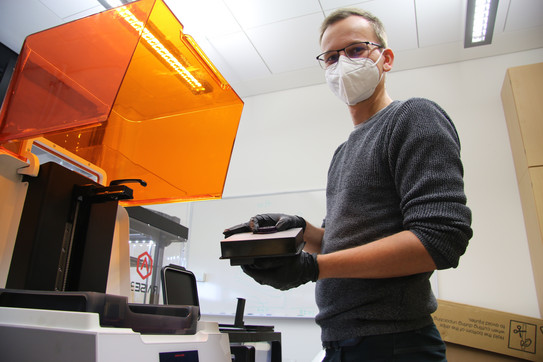Medical physics
Brachytherapy of intraocular tumors
Ocular tumors are a rare tumor disease that is treated at only a few centers. The goal of therapy is not only to cure the tumor disease but to preserve the eye and its function. In our research group, we work in close cooperation with the University Hospital Essen, one of the leading centers in this field, on problems and issues arising from brachytherapy of ocular tumors. In this form of therapy, a radioactive source is fixed on the affected eye utilizing an eye applicator.
As the brachytherapy uses Ruthenium-106 plaques, which is a beta emitter, it is limited to apex heights of about 6 mm, depending on the plaque model. Larger tumors often lead to the enucleation of the eye, which is a significant loss in quality of life, especially for children. Therefore, we developed a combined concept consisting of brachytherapy and X-ray irradiation. We focus on the first proof of concept and initial estimates regarding the benefit of using the combined therapy concept.
Dosimetry
The knowledge of the exact 3D dose distribution of the ocular applicators in the eye and tumor is crucial for the success of the therapy. Still, the precise, complete measurement of each applicator is too time-consuming, especially for clinical routine. Therefore, a method is developed to determine, with a small amount of time, each applicator's individual 3D dose rate profile, taking into account its inhomogeneities, from the combination of a general simulated baseline data set and the surface dose rate profile measured specifically for each applicator.

For the measurement of brachytherapy sources, two shielded measuring stations are available in our laboratory. In addition to a measuring apparatus specially adapted to the dome shape of ocular applicators for recording surface dose rate profiles, we also use an XYZ measuring stage with a positioning accuracy of 1 µm. The detectors we mainly use are plastic scintillators read out by photomultipliers. For the calibration of our detector system in the unit of absorbed dose to water, we closely cooperate with the Physikalisch-Technische Bundesanstalt in Braunschweig. To simplify the use in clinical routine, the measurement of the applicators will be automated to a large extent in the future.
Another collaboration exists with the company Wolf Medizintechnik, which, among other things, sells X-ray tubes worldwide. This allows us to expand our simulation results with practical experience and measurements with possible X-ray tubes for the combined therapy concept.
Monte-Carlo simulations
In addition to experimental measurements, there is also the possibility of performing computer simulations for dosimetry. Since radiation transport in matter is generally too complicated for analytical treatment, Monte-Carlo simulations are often used in medical physics to calculate dose distributions. In the Monte Carlo method, possible trajectories for a large number of individual particles are "diced", considering the probability distributions of physical interactions and transport quantities. Doing so collects information about the relevant physical quantities to determine their mean values and distributions. This way, for example, measurements can be verified, or quantities inaccessible to measurement can be determined. We also used Monte-Carlo simulations to investigate the influence of different materials or geometric arrangements in the new development of eye applicators.

